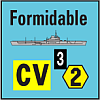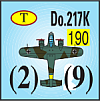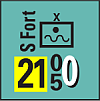
18.0 Naval Power
Skip this entire section if the game being played does not include ships!
Naval warfare is handled fairly simply, because the series is built around land and air combat. However, some detail in naval operations is needed to allow for campaigns with an important naval component (specifically naval gunfire support and amphibious landings).
18.2 Aircraft Carriers
18.2a Capacity.
Carriers are limited in the number and type of aircraft they carry. In some games, only planes with the carrier’s name on them can use that carrier. In other games, each carrier has a number on it for how many aircraft it can support (counting both Inactive and Active aircraft).
18.2b Refit. Carriers can refit all of their planes in the Aircraft Refit Phase. Exception: Damaged carriers can only refit 2 planes (regardless of their normal rating). There is no SP cost.
18.2c Carrier Planes. Air units on a carrier perform missions and project Patrol Zones from the carrier’s hex. A carrier can move in the same segment, either before or after, its planes perform missions. Aircraft stay with a carrier as it moves—and this includes a “move” to the Dead Pile. (Note tagging along with a moving carrier is not treated as a mission.) Otherwise, carrier planes operate as regular aircraft.
18.2d Surface ship gunfire cannot be directed at a carrier if any non-carrier surface ships are in range. This rule does not apply to coastal artillery gunfire (18.3g).
This rule shows the effort by members of a carrier group to defend the carrier. A surface attack will not get to the carrier until the screen is eliminated.
18.4 Landing Craft

Landing Craft, DUKWs, and LSTs are collectively called “Landing Craft.” These are naval units used to deliver cargo (troops and supplies) to invasion beaches. Landing Craft do not have a Flak value or Barrage Strength.
18.4a Capacity. Landing Craft have a capacity number on the counter and function much like Transport Points. They do not count for stacking.
18.4b Movement. Landing Craft are slow ships (18.1f). Exception: DUKW can only move 8 hexes per phase.
18.4c Loading. Landing Craft can carry combat units, SP, and Transport Points up to the limit of their capacity (see 4.7 for Transportation Equivalents). Loading has no movement cost, can only be done in port hexes (subject to current capacity), and the cargo cannot have been moved before being loaded.
18.4d Handling. Handle Landing Craft like SP and Transport Points—they can be split up and combined in various combinations of points. When taking losses, either from ALT results or from barrage, just replace the current counter with a Landing Craft of the reduced number of points. LSTs are an exception (see 18.3d).
18.4e DUKWs.

In addition to being Landing Craft, DUKWs can operate as Transport Points (see 13.2; captured as a Truck per 9.14c). When moving as Transport Points, DUKWs lose their ability to move in all three Movement Segments, but their MA is tripled to 24. The switch between Landing Craft and Transport Point (and vice versa) can occur at any time during the Movement Phase—just triple the remaining MA when it starts to move by land (or divide by 3 when it starts to move by water).
In addition…
- A) Make an ALT roll (see 18.5f) each time the DUKW switches movement type from Landing Craft to Transport Point (not vice versa). This can be the same roll used to unload cargo (but this will end movement, per 18.5a).
- B) When acting as Landing Craft, DUKWs can only carry the cargo types allowed on Air Transport Missions (restricted as per 14.9c). Treat as a Landing Craft if overrun (9.14g). Unloaded ground units can move after landing (18.5h).
- C) When acting as Transport Points, DUKWs can only carry SP. Treat as a truck when overrun (9.14c). Loading/unloading cost is 2 MP (per 4.7d and 13.2f).
18.4f LSTs.

In addition to being a type of Landing Craft, an LST in a coastal or estuary hex can be converted into a port (by flipping to its port side). This ‘conversion’ requires an ALT roll (see 18.5f). Any cargo on the LST unloads when it deploys as a port, using the same ALT roll as the port deployment. (The cargo is landed before the port exists in the hex, so note the restrictions of 18.5e do apply.)
Some special rules apply to LST ports:
- A) Unlike regular ports, they cannot be targeted by barrage (the hex can be barraged, but the port ignores any result).
- B) They are destroyed when an enemy Attack-Capable unit enters its hex. They can never be destroyed or captured by any other method.
- C) They can never move or convert back into an LST.
- D) They are a 1 SP port, which makes them a supply source.
- E) LST ports are not functional in the phase they deploy. (So in that phase no shipping is allowed into the port and the port does not assist other ALT rolls.)
- F) An LST cannot convert into a port in a hex with another port.
18.5 Amphibious Landings
Landing Craft can unload the combat units they are transporting when they end movement in coastal hexes. The risk attached to such landings is reflected by the required roll on the Amphibious Landing Table (ALT). These landings are limited to undefended coastal hexes. For hexes occupied by enemy combat units, see Beach Assaults (18.6).
18.5a There is no movement cost for unloading; just drop off the units when the Landing Craft enters the coastal hex. The Landing Craft must end its move at that point.
18.5b Any number of Landing Craft points can unload in a given hex in one phase.
18.5c Combat units must unload in either Combat or Move Mode.
18.5d Landings requiring an ALT roll can only be done during the player’s Movement Phase. Note that landings in ports which do not require an ALT roll can also be done in Reaction and Exploitation Phases (see 18.5g) — this is a way to get extra cargo ashore!
18.5e Transport Points and SP cannot be landed by ALT roll (but see 18.5g). SP loaded on Landing Craft can only be used by units in the same or an adjacent hex (even if off-shore), and HQs are not allowed to “throw” supply drawn from a Landing Craft.
18.5f The ALT Roll. Make ALT rolls after all Landing Craft have finished moving for the phase. Roll two dice per hex containing units that landed during the phase. Add applicable modifiers and execute the result.
- A) When there are several types of terrain in the hex, use the most difficult on the ALT.
- B) Roll and carry out ALT results separately for every group of 3 RE landed in a hex. Make as few rolls as possible, but otherwise a player can arrange units into these groups as desired.
- C) When partial losses are required by the ALT result, randomly choose the lost Landing Craft and cargo.
- D) Wait to do “after landing” moves (18.5h) until all of the player’s ALT rolls have been made.
- E) When entering a hex with enemy non-combat units, resolve Specialized Combats (9.14) after making the ALT roll.
√18.5g Ports. Do not make an ALT roll for Landing Craft that unload cargo using a friendly port’s capacity (19.0a). (Additional units can be landed in a port hex, but these do require an ALT roll.) When no ALT roll is required, SP and loaded Transport Points can be unloaded.
√18.5h After Landing. Combat units can move 1/2 their MA during that same Movement Phase after an ALT landing (per 4.7d). Such units are fueled before landing for free (at no SP cost) via the “single-unit method” (see 12.5c(C)). DUKW can move a proportion of their remaining MA (per 18.4e).
- Units that come ashore without an ALT roll (via 18.5g) do not get any after-landing movement.
18.6 Beach Assaults
Landing Craft can position units for an assault on a coastal hex that contains enemy combat units. Think of Beach Assaults (BA) as a last resort, when landings via the ALT are not possible.
18.6a Resolve Beach Assaults during the friendly Combat Phase. Several special rules apply:
- A) The attacking units in a BA must be in Combat Mode, stacked in the same hex, and total no more than 3 RE.
- B) Combat supply for a BA can be drawn only from Landing Craft carrying Supply Points in the same or an adjacent hex.
- C) All atacker option results must be taken as step losses.
- D) Units making a BA can keep any Exploit marker they might earn.
- E) If the BA does not dislodge the defenders from the hex, destroy all attacking units and also their Landing Craft.
- F) There is a nominal hexside terrain that makes all units ×1/2 when attacking in a BA. The defender can choose that or the hex terrain in 9.4b.
- G) BA combats cannot be made in conjunction with attacking units that have already landed.
- H) If all of the defenders are destroyed by a barrage, resolve the assault on the ALT instead (but there is no “after landing” movement).
18.6b Just before the execution of a BA, the defending player can opt to resolve the landing as an ALT instead of as a BA. (This can be done if the odds are overwhelming and an ALT roll has a better chance of inflicting losses.) The decision cannot be changed once made, and must be made before any dice are rolled, units exposed, or combat supply paid. Spend no supply for a BA resolved on the ALT.
If the defender makes this choice, the normal ALT procedure is modified as follows:
- Regardless of the ALT result, the defenders are destroyed.
- Unloaded units advance into the vacated hex, but there is no “after landing” movement (per 4.7d).


